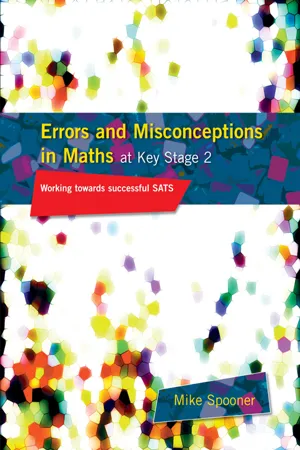
Errors and Misconceptions in Maths at Key Stage 2
Working Towards Success in SATS
- 64 pages
- English
- ePUB (mobile friendly)
- Available on iOS & Android
About this book
The activities in this book are designed both to help children to learn and to understand math concepts, and also to prepare them for taking SATS papers at KS2. There is plenty of research evidence to suggest that children are helped in their understanding of math problems if teachers focus on common misconceptions, and if children are given opportunities for discussion and explanation of their own understanding. Children can also feel stigmatized by being made to focus on their own errors.
Mike Spooner has developed activities that present already completed work which children then assess, correct and discuss - in this way they can analyze mistakes without damage to their own self-esteem. The activities are presented in the same format as the SATS papers, to give children practice in coping with that format. The book also contains writing frames that children can use to structure their discussions of math problems.
Frequently asked questions
- Essential is ideal for learners and professionals who enjoy exploring a wide range of subjects. Access the Essential Library with 800,000+ trusted titles and best-sellers across business, personal growth, and the humanities. Includes unlimited reading time and Standard Read Aloud voice.
- Complete: Perfect for advanced learners and researchers needing full, unrestricted access. Unlock 1.4M+ books across hundreds of subjects, including academic and specialized titles. The Complete Plan also includes advanced features like Premium Read Aloud and Research Assistant.
Please note we cannot support devices running on iOS 13 and Android 7 or earlier. Learn more about using the app.
Information
Using the Exercises
- Explain to the Children that: • they will be working with exercises that have been completed by other children;• in all the exercises some or all of the answers are incorrect;• the number of errors they should find is written at the start of each separate section of the exercise.
- Ask the children to: • mark the work and establish which examples are incorrect;• suggest why the ‘unknown child’ might have made the errors;• suggest ways in which they would help the child overcome the problems exhibited (what would they say, is there any equipment or diagram they might use, etc.?);• prepare to report back to the rest of the class in a plenary session.
- Organising the class. In the trials the exercises were used within the standard structure of the daily mathematics lesson. Discussion was achieved either with the whole class looking at some examples or with small groups working alone before reporting back to the class in the plenary session. In some classes children worked in groups on different topics and took responsibility for reporting back to the rest of the class on specific errors to avoid. They also made posters to support and reinforce their advice.
- Setting up the tasks for children working in unsupported groups. Writing frames will help to structure the report (Appendices B and C). Copies of the briefing sheet can be placed on the desk for children and learning support assistants to refer to (Appendix A).
- Teacher’s notes. The teacher’s notes summarise aspects of the problem and refer to relevant comments from the Standards reports (QCA 1999 and 2000).
The Exercises
Numbers and the Number System
Some Problem Areas
- The examples in this section will check on the definition of the terms prime, multiple and factor.
- Dealing with intersections and membership of more than one set in Carroll and Venn diagrams.
Evidence from SATs
From QCA (2000):
Teaching Points
- The error exercises will be useful in getting children to provide clear definitions of the terms prime, multiple and factor.
- Venn and Carroll diagrams are often used in SATs. It can be very useful to describe what each area of the diagram will contain, e.g.

- The final exercise in this section looks at the effects of adding 1,10,100 and 1000. Children who find this difficult would benefit from seeing concrete models of these operations, e.g. ‘If 990 were modelled with Diene’s apparatus and 10 were add...
Table of contents
- Cover Page
- Half Title page
- Title Page
- Copyright Page
- Contents
- Introduction Error Correction Exercises
- Using the Exercises
- The Exercises
- Appendix A
- Appendix B
- Appendix C
- Bibliography